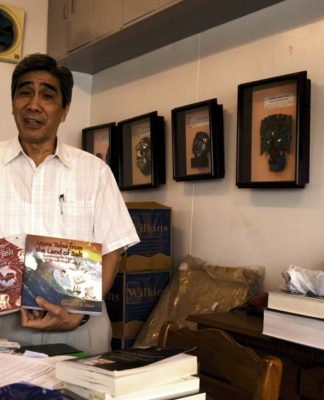A LOCAL antioxidant against dangerous free radicals.
The antioxidant properties of Ficus pseudopalma, an endemic medicinal plant commonly known as niyog-niyogan and is widely cultivated in Lake Buhi in Camarines Sur, were revealed in a study conducted by Librado Santiago, a professor from the Biochemistry Department of the Faculty of Pharmacy.
In his paper, titled “Lupeol: An Antioxidant Triterpene in Ficus pseudopalma Blanco (Moraceae),” which was published at the Asian Pacific Journal of Tropical Biomedicine, he noted the importance of lupeol—a particular chemical compound found in the plant as the possible source of its antioxidant property essential in combating free radicals in the body.
Although free radicals play a vital role in various biological processes and “have been linked to the killing of cancer cells,” Santiago said excessive production of these substances could damage the cells and eventually lead to cell death.
“Due to the presence of a lone pair of electrons, free radicals become very reactive that it can easily attach to the proteins and lipids inside the body,” said Santiago, who is also a researcher at the Research Center for the Natural and Applied Sciences.
Moreover, he emphasized two mechanisms involved in the plant’s antioxidant activity—electron donation and compound reduction.
“The electron donating capacity of F. pseudopalma allows it to attach to and arrest free radicals. Its ability to reduce chemicals also indicates its antioxidant capacity,” Santiago said.
His team also performed a specific antioxidant test to evaluate how this plant affects the activity of most common free radicals produced in the body.
“We tested its ability to inhibit free radicals like superoxide, hydroxyl and nitric oxide radicals, which are produced as by-products during normal metabolism of aerobic organisms,” Santiago said.
The researcher warned that if the production of free radicals in the body is not maintained to a healthy level, oxidative stress may occur and could lead to the growth of cancer cells or even death, especially as one ages.
“Since these free radicals are normally produced in the body, it is significant that overproduction of these should be taken care of by supplemental intake of antioxidants,” Santiago said.
Supplemental benefits
Santiago said his team was developing F. pseudopalma as a food supplement that could serve as a primary defense against free radicals, scavenging on the damage-causing microorganisms.
He noted that the plant was proven to be non-toxic after carrying out experiments using animal models.
“We performed the test on rats and were able to scientifically document that F. pseudopalma is non-toxic, even to the organs, and that its young shoots can be eaten raw,” Santiago told the Varsitarian.
Based on tests, he pointed out that the most significant health benefit the plant could offer is its antidiabetic capacity, although F. pseudopalma’s capabilities to treat hypertension and kidney stones were also observed.
He said turning it into a food supplement would not only benefit human health, but the agri-economy as well.
“The production of these would create employment because the commercialization of the product would be consuming a lot of F. pseudopalma leaves,” Santiago said.
















